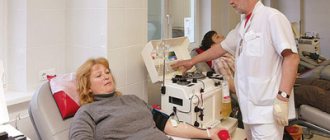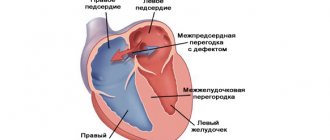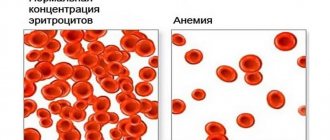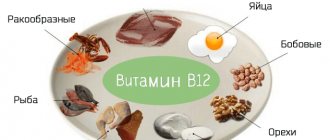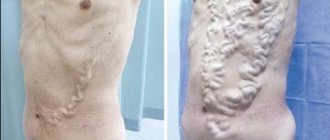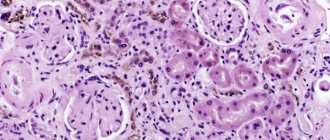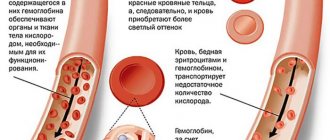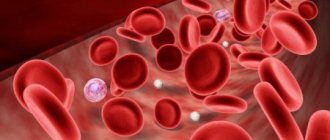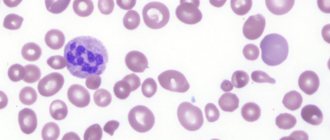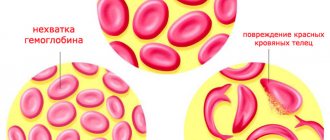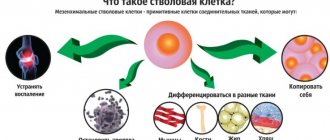NUTRITION-RELATED ANEMIA (D50-D53)
D50 Iron deficiency anemia
Included: anemia: . sideropenic. hypochromic D50.0 Iron deficiency anemia secondary to blood loss (chronic). Posthemorrhagic (chronic) anemia. Excluded: acute posthemorrhagic anemia (D62) congenital anemia due to fetal blood loss (P61.3) D50.1 Sideropenic dysphagia. Kelly-Paterson syndrome. Plummer-Vinson syndrome D50.8 Other iron deficiency anemia D50.9 Iron deficiency anemia, unspecified
D51 Vitamin B12 deficiency anemia
Excludes: vitamin B12 deficiency (E53.8)
D51.0 Vitamin B12 deficiency anemia due to intrinsic factor deficiency. Anemia: . Addison. Birmera. pernicious (congenital) Congenital deficiency of intrinsic factor D51.1 Vitamin B12 deficiency anemia due to selective malabsorption of vitamin B12 with proteinuria. Imerslund(-Gresbeck) syndrome. Megaloblastic hereditary anemia D51.2 Transcobalamin II deficiency D51.3 Other vitamin B12 deficiency anemias associated with nutrition. Anemia of vegetarians D51.8 Other vitamin B12 deficiency anemia D51.9 Vitamin B12 deficiency anemia, unspecified
D52 Folate deficiency anemia
D52.0 Folate deficiency anemia associated with nutrition. Megaloblastic nutritional anemia D52.1 Folate deficiency anemia drug-induced. If it is necessary to identify the drug, use an additional code for external causes (class XX) D52.8 Other folate deficiency anemia D52.9 Folate deficiency anemia, unspecified. Anemia due to insufficient intake of folic acid, NOS
D53 Other diet-related anemias
Included: megaloblastic anemia not responding to vitamin B12 or folate supplementation
D53.0 Anemia due to protein deficiency. Anemia due to amino acid deficiency. Orotaciduric anemia Excludes: Lesch-Nyhan syndrome (E79.1) D53.1 Other megaloblastic anemia, not elsewhere classified. Megaloblastic anemia NOS. Excludes: Di Guglielmo's disease (C94.0) D53.2 Anemia due to scurvy. Excludes: scurvy (E54) D53.8 Other specified anemias associated with nutrition. Anemia associated with deficiency: . copper molybdenum zinc Excludes: malnutrition without mention of anemia, such as: . copper deficiency (E61.0). molybdenum deficiency (E61.5). zinc deficiency (E60) D53.9 Diet-related anemia, unspecified. Simple chronic anemia. Excludes: anemia NOS (D64.9)
Symptoms
The main symptoms of Werlhof's disease are hemorrhages in the skin and bleeding from the epithelial membranes, which occur spontaneously or under the influence of minor injuries. There are two variants of the disease:
- “dry” – accompanied only by cutaneous hemorrhagic syndrome;
- “wet” – characterized by a combination of hemorrhages and bleeding.
Features of dermatological manifestations:
- the size of hemorrhages varies from pinpoint petechiae to large-scale ecchymoses;
- discrepancy between the degree of hemorrhage and the level of traumatic impact;
- the color of the spots changes from purple to greenish-yellow (it is determined by the stage of hemoglobin breakdown);
- petechiae and ecchymoses are painless and appear asymmetrically;
Hemorrhages into the mucous membranes are localized in the oral cavity, sclera, fundus, and eardrums.
In the “wet” version of a pathology such as Werlhof’s disease or thrombocytopenic purpura, bleeding from the nasal passages (typical of children), gums (especially after dental procedures), and the oral cavity is observed. Women may experience uterine bleeding. Renal and gastrointestinal bleeding rarely occur.
Depending on the duration of the disease, there are acute (up to 6 months) and chronic (more than 6 months) forms with varying relapse rates. In the cyclic course of thrombocytopenic purpura, three periods are distinguished:
- Hemorrhagic crisis. Skin hemorrhage and bleeding are observed, as well as significant deviations in hematological parameters.
- Clinical remission. There are no external manifestations of the disease, thrombocytopenia persists.
- Clinical and hematological remission. Hematological markers are normalized.
Werlhof's disease in children and adults in most cases is not accompanied by other pathological manifestations, since the condition of the internal organs does not change.
Without treatment, the pathology can lead to:
- severe anemia;
- profuse bleeding;
- disruption of the cardiovascular system.
The most severe complication of the pathology is hemorrhage in the brain. Its symptoms:
- redness of the sclera;
- Strong headache;
- convulsions;
- vomit;
- neurological disorders.
HEMOLYTIC ANEMIA (D55-D59)
D55 Anemia due to enzyme disorders
Excludes: drug-induced enzyme deficiency anemia (D59.2)
D55.0 Anemia due to glucose-6-phosphate dehydrogenase [G-6-PD] deficiency. Favism. G-6-PD deficiency anemia D55.1 Anemia due to other disorders of glutathione metabolism. Anemia due to enzyme deficiencies (except G-6PD) associated with the hexose monophosphate [HMP] metabolic pathway shunt. Hemolytic non-spherocytic anemia (hereditary) type 1 D55.2 Anemia due to disorders of glycolytic enzymes. Anemia: . hemolytic non-spherocytic (hereditary) type II. due to hexokinase deficiency. due to pyruvate kinase deficiency. due to deficiency of triosephosphate isomerase D55.3 Anemia due to disorders of nucleotide metabolism D55.8 Other anemia due to enzyme disorders D55.9 Anemia due to enzyme disorders, unspecified
D56 Thalassemia
D56.0 Alpha thalassemia. Excludes: hydrops fetalis due to hemolytic disease (P56. -) D56.1 Beta thalassemia. Cooley's anemia. Severe beta thalassemia. Sickle cell beta thalassemia. Thalassemia: . intermediate major D56.2 Delta-beta-thalassemia D56.3 Carriage of thalassemia trait D56.4 Hereditary persistence of fetal hemoglobin [HFH] D56.8 Other thalassemia D56.9 Thalassemia, unspecified. Mediterranean anemia (with other hemoglobinopathy) Thalassemia minor (mixed) (with other hemoglobinopathy)
D57 Sickle cell disorders
Excludes: other hemoglobinopathies (D58. -) sickle cell beta thalassemia (D56.1)
D57.0 Sickle cell anemia with crisis. Hb-SS disease with crisis D57.1 Sickle cell anemia without crisis. Sickle cell: . anemia } . disease } NOS . disorder } D57.2 Double heterozygous sickle cell disorder Disease: . Hb-SC. Hb-SD. Hb-SE D57.3 Carriage of the sickle cell trait. Carriage of hemoglobin S[Hb-S]. Heterozygous hemoglobin S D57.8 Other sickle cell disorders
D58 Other hereditary hemolytic anemias
D58.0 Hereditary spherocytosis. Acholuric (familial) jaundice. Congenital (spherocytic) hemolytic jaundice. Minkowski-Choffard syndrome D58.1 Hereditary elliptocytosis. Ellitocytosis (congenital). Ovalocytosis (congenital) (hereditary) D58.2 Other hemoglobinopathies. Abnormal hemoglobin NOS. Congenital anemia with Heinz bodies. Disease: . Hb-C. Hb-D. Hb-E Hemolytic disease caused by unstable hemoglobin. Hemoglobinopathy NOS. Excluded: familial polycythemia (D75.0) Hb-M disease (D74.0) hereditary persistence of fetal hemoglobin (D56.4) polycythemia associated with altitude (D75.1) methemoglobinemia (D74. -) D58.8 Other specified hereditary hemolytic diseases anemia. Stomatocytosis D58.9 Hereditary hemolytic anemia, unspecified
D59 Acquired hemolytic anemia
D59.0 Drug-induced autoimmune hemolytic anemia. If it is necessary to identify the drug, use an additional code for external causes (class XX). D59.1 Other autoimmune hemolytic anemias. Autoimmune hemolytic disease (cold type) (warm type). Chronic disease caused by cold hemagglutinins. "Cold agglutinin": . disease . hemoglobinuria Hemolytic anemia: . cold type (secondary) (symptomatic). heat type (secondary) (symptomatic) Excludes: Evans syndrome (D69.3) hemolytic disease of the fetus and newborn (P55. -) paroxysmal cold hemoglobinuria (D59.6) D59.2 Drug -induced non-autoimmune hemolytic anemia. Drug-induced enzyme deficiency anemia. If it is necessary to identify the drug, use an additional code for external causes (class XX). D59.3 Hemolytic-uremic syndrome D59.4 Other non-autoimmune hemolytic anemias. Hemolytic anemia: . mechanical microangiopathic. toxic If it is necessary to identify the cause, use an additional code for external causes (class XX). D59.5 Paroxysmal nocturnal hemoglobinuria [Marchiafava-Micheli]. Excludes: hemoglobinuria NOS (R82.3) D59.6 Hemoglobinuria due to hemolysis caused by other external causes. Hemoglobinuria: . from load. marching paroxysmal cold If necessary, identify the cause, use an additional code for external causes (class XX). Excludes: hemoglobinuria NOS (R82.3) D59.8 Other acquired hemolytic anemia D59.9 Acquired hemolytic anemia, unspecified. Chronic idiopathic hemolytic anemia
APLASTIC AND OTHER ANEMIA (D60-D64)
D60 Acquired pure red cell aplasia (erythroblastopenia)
Includes: red cell aplasia (acquired) (adults) (with thymoma)
D60.0 Chronic acquired pure red cell aplasia D60.1 Transient acquired pure red cell aplasia D60.8 Other acquired pure red cell aplasia D60.9 Acquired pure red cell aplasia, unspecified
D61 Other aplastic anemias
Excluded: agranulocytosis (D70)
D61.0 Constitutional aplastic anemia. Aplasia (pure) red cell: . congenital nursery primary Blackfan-Diamond syndrome. Familial hypoplastic anemia. Fanconi anemia. Pancytopenia with developmental defects D61.1 Drug-induced aplastic anemia. If it is necessary to identify the drug, use an additional code for external causes (class XX). D61.2 Aplastic anemia caused by other external agents. If it is necessary to identify the cause, use an additional code of external causes (class XX). D61.3 Idiopathic aplastic anemia D61.8 Other specified aplastic anemia D61.9 Aplastic anemia, unspecified. Hypoplastic anemia NOS. Bone marrow hypoplasia. Panmyelophthisis
D62 Acute posthemorrhagic anemia
Excludes: congenital anemia due to fetal blood loss (P61.3)
D63 Anemia in chronic diseases classified elsewhere
D63.0 Anemia in neoplasms (C00-D48+) D63.8 Anemia in other chronic diseases classified elsewhere
D64 Other anemias
Excluded: refractory anemia: . NOS (D46.4) . with excess blasts (D46.2). with transformation (D46.3) . with sideroblasts (D46.1). without sideroblasts (D46.0)
D64.0 Hereditary sideroblastic anemia. Sex-linked hypochromic sideroblastic anemia D64.1 Secondary sideroblastic anemia due to other diseases. If necessary, an additional code is used to identify the disease. D64.2 Secondary sideroblastic anemia caused by drugs or toxins. If it is necessary to identify the cause, use an additional code of external causes (class XX). D64.3 Other sideroblastic anemias. Sideroblastic anemia: . NOS. pyridoxine-responsive, not elsewhere classified D64.4 Congenital dyserythropoietic anemia. Dyshematopoietic anemia (congenital). Excluded: Blackfan-Diamond syndrome (D61.0) Di Guglielmo disease (C94.0) D64.8 Other specified anemias. Childhood pseudoleukemia. Leukoerythroblastic anemia D64.9 Anemia, unspecified
Causes
The causes of Werlhof's disease have not been reliably established. It is assumed that the main role is played by the inferiority of the platelet component of hemostasis, which is inherited according to an autosomal dominant principle. In addition, the pathology may be associated with the production of antiplatelet antibodies, which destroy platelets.
In 45% of situations, idiopathic thrombocytopenic purpura in adults and children develops spontaneously. In 40% of cases it is preceded by:
- viral diseases - chickenpox, rubella, mumps, measles, mononucleosis;
- bacterial pathologies – whooping cough;
- vaccination;
- taking medications (estrogen, sulfonamide) or toxic substances (mercury, arsenic, barbiturates);
- prolonged exposure to x-rays;
- excessive sun exposure;
- injuries;
- surgical interventions.
Idiopathic thrombocytopenic purpura in children under one year of age is often caused by transplacental transfer of antiplatelet antibodies from the mother. This is possible if:
- a woman suffers from Werlhof's disease;
- There is antigenic incompatibility between mother and fetus platelets.
HEMORRHAGIC CONDITIONS (D65-D69)
D65 Disseminated intravascular coagulation [defibration syndrome]
Afibrinogenemia acquired. Consumptive coagulopathy Diffuse or disseminated intravascular coagulation [DJC] Fibrinolytic bleeding acquired Purpura: . fibrinolytic. fulminant Excluded: defibration syndrome (complicating): . abortion, ectopic or molar pregnancy (O00-O07, O08.1). in a newborn (P60). pregnancy, childbirth and the puerperium (O45.0, O46.0, O67.0, O72.3)
D66 Hereditary factor VIII deficiency
Factor VIII deficiency (with functional impairment) Hemophilia: . NOS. A . classical Excludes: factor VIII deficiency with vascular disorder (D68.0)
D67 Hereditary factor IX deficiency
Christmas Disease Deficiency: . factor IX (with functional impairment). thromboplastic plasma component Hemophilia B
D68 Other bleeding disorders
Excluded: complicating: . abortion, ectopic or molar pregnancy (O00-O07, O08.1). pregnancy, childbirth and the puerperium (O45.0, O46.0, O67.0, O72.3)
D68.0 Von Willebrand's disease. Angiohemophilia. Factor VIII deficiency with vascular impairment. Vascular hemophilia. Excluded: hereditary capillary fragility (D69.8) factor VIII deficiency: . NOS (D66) . with functional impairment (D66) D68.1 Hereditary deficiency of factor XI. Hemophilia C. Plasma thromboplastin precursor deficiency D68.2 Hereditary deficiency of other coagulation factors. Congenital afibrinogenemia. Shortage: . AC globulin. proaccelerin factor deficiency: . I [fibrinogen]. II [prothrombin]. V [labile]. VII [stable]. X [Stuart-Prower]. XII [Hageman]. XIII [fibrin-stabilizing] Dysfibrinogenemia (congenital). Hypoproconvertinemia. Ovren's disease D68.3 Hemorrhagic disorders caused by anticoagulants circulating in the blood. Hyperheparinemia. Increased content: . antithrombin. anti-VIIIa. anti-IXa. anti-Xa. anti-XIa If necessary, identify the anticoagulant used, use an additional code for external causes (class XX). D68.4 Acquired coagulation factor deficiency. Coagulation factor deficiency due to: . liver diseases. vitamin K deficiency Excludes: vitamin K deficiency in the newborn (P53) D68.8 Other specified coagulation disorders. Presence of systemic lupus erythematosus inhibitor D68.9 Coagulation disorder, unspecified
D69 Purpura and other hemorrhagic conditions
Excluded: benign hypergammaglobulinemic purpura (D89.0) cryoglobulinemic purpura (D89.1) idiopathic (hemorrhagic) thrombocythemia (D47.3) purpura fulminans (D65) thrombotic thrombocytopenic purpura (M31.1)
D69.0 Allergic purpura. Purpura: . anaphylactoid. Henoch(-Schönlein). non-thrombocytopenic: . hemorrhagic. idiopathic. vascular Allergic vasculitis D69.1 Qualitative platelet defects. Bernard-Soulier syndrome [giant platelets]. Glanzmann's disease. Gray platelet syndrome. Thrombasthenia (hemorrhagic) (hereditary). Thrombocytopathy. Excludes: von Willebrand disease (D68.0) D69.2 Other non-thrombocytopenic purpura. Purpura: . NOS. senile simple D69.3 Idiopathic thrombocytopenic purpura. Evans syndrome D69.4 Other primary thrombocytopenias. Excluded: thrombocytopenia with absent radius (Q87.2) transient neonatal thrombocytopenia (P61.0) Wiskott-Aldrich syndrome (D82.0) D69.5 Secondary thrombocytopenia. If it is necessary to identify the cause, use an additional external cause code (class XX). D69.6 Thrombocytopenia, unspecified D69.8 Other specified hemorrhagic conditions. Capillary fragility (hereditary). Vascular pseudohemophilia D69.9 Hemorrhagic condition, unspecified
general information
Thrombocytopenia is a condition in which the platelet count is below normal (180-320x109/l). Platelets are synthesized by megakaryocytes in the bone marrow and are responsible for blood clotting. A decrease in their concentration leads to increased bleeding. Thrombocytopenia of unknown etiology is classified as Werlhof's disease or idiopathic purpura.
Werlhof's disease was first described in 1735 by the German physician Paul Werlhof, but references to its symptoms were found in the writings of Hippocrates. Idiopathic thrombocytopenic purpura is the most common form of primary hemorrhagic diathesis (40% of cases).
As a rule, the pathology manifests itself in childhood, affecting boys and girls with equal frequency. In older age groups, women encounter it 2-3 times more often during the period of hormonal changes (15-20 and 40-50 years). From 1 to 13 cases of Werlhof's disease per 100,000 people are registered annually.
OTHER DISEASES OF THE BLOOD AND BLOOD FORMING ORGANS (D70-D77)
D70 Agranulocytosis
Agranulocytic tonsillitis. Children's genetic agranulocytosis. Kostmann's disease Neutropenia: . NOS. congenital cyclic medicinal. periodic splenic (primary). toxic Neutropenic splenomegaly If it is necessary to identify the drug causing neutropenia, use an additional code for external causes (class XX). Excludes: transient neonatal neutropenia (P61.5)
D71 Functional disorders of polymorphonuclear neutrophils
Defect of the cell membrane receptor complex. Chronic (children's) granulomatosis. Congenital dysphagocytosis Progressive septic granulomatosis
D72 Other white blood cell disorders
Excluded: basophilia (D75.8) immune disorders (D80-D89) neutropenia (D70) preleukemia (syndrome) (D46.9)
D72.0 Genetic abnormalities of leukocytes. Anomaly (granulation) (granulocyte) or syndrome: . Aldera. May-Hegglina. Pelguera-Hueta Hereditary: . leukocyte. hypersegmentation. hyposegmentation. leukomelanopathy Excluded: Chediak-Higashi (-Steinbrink) syndrome (E70.3) D72.1 Eosinophilia. Eosinophilia: . allergic. hereditary D72.8 Other specified disorders of white blood cells. Leukemoid reaction: . lymphocytic. monocytic. myelocytic leukocytosis. Lymphocytosis (symptomatic). Lymphopenia. Monocytosis (symptomatic). Plasmacytosis D72.9 White blood cell disorder, unspecified
D73 Diseases of the spleen
D73.0 Hyposplenism. Postoperative asplenia. Atrophy of the spleen. Excludes: asplenia (congenital) (Q89.0) D73.1 Hypersplenism Excludes: splenomegaly: . NOS (R16.1) . congenital (Q89.0) D73.2 Chronic congestive splenomegaly D73.3 Splenic abscess D73.4 Splenic cyst D73.5 Splenic infarction. Splenic rupture is non-traumatic. Torsion of the spleen. Excludes: traumatic rupture of the spleen (S36.0) D73.8 Other diseases of the spleen. Splenic fibrosis NOS. Perisplenitis. Splenitis NOS D73.9 Disease of the spleen, unspecified
D74 Methemoglobinemia
D74.0 Congenital methemoglobinemia. Congenital deficiency of NADH-methemoglobin reductase. Hemoglobinosis M [Hb-M disease]. Hereditary methemoglobinemia D74.8 Other methemoglobinemia. Acquired methemoglobinemia (with sulfhemoglobinemia). Toxic methemoglobinemia. If it is necessary to identify the cause, use an additional external cause code (class XX). D74.9 Methemoglobinemia, unspecified
D75 Other diseases of the blood and hematopoietic organs
Excluded: enlarged lymph nodes (R59. -) hypergammaglobulinemia NOS (D89.2) lymphadenitis: . NOS (I88.9) . acute (L04. -) . chronic (I88.1). mesenteric (acute) (chronic) (I88.0)
D75.0 Familial erythrocytosis. Polycythemia: . benign. familial Excluded: hereditary ovalocytosis (D58.1) D75.1 Secondary polycythemia. Polycythemia: . acquired . related to: . erythropoietins. decrease in plasma volume. height stress. emotional. hypoxemic. nephrogenic. relative Excluded: polycythemia: . newborn (P61.1) . true (D45) D75.2 Essential thrombocytosis. Excludes: essential (hemorrhagic) thrombocythemia (D47.3) D75.8 Other specified diseases of the blood and hematopoietic organs. Basophilia D75.9 Disease of the blood and hematopoietic organs, unspecified
D76 Selected diseases involving lymphoreticular tissue and the reticulohistiocytic system
Excludes: Letterer-Sieve disease (C96.0) malignant histiocytosis (C96.1) reticuloendotheliosis or reticulosis: . histiocytic medullary (C96.1). leukemic (C91.4). lipomelanotic (I89.8). malignant (C85.7). non-lipidic (C96.0)
D76.0 Langerhans cell histiocytosis, not elsewhere classified. Eosinophilic granuloma. Hand-Schueller-Crisgen disease. Histiocytosis X (chronic) D76.1 Hemophagocytic lymphohistiocytosis. Familial hemophagocytic reticulosis. Histiocytoses from mononuclear phagocytes other than Langerhans cells, NOS D76.2 Hemophagocytic syndrome associated with infection. If it is necessary to identify an infectious pathogen or disease, an additional code is used. D76.3 Other histiocytosis syndromes. Reticulohistiocytoma (giant cell). Sinus histiocytosis with massive lymphadenopathy. Xanthogranuloma
D77 Other disorders of the blood and hematopoietic organs in diseases classified elsewhere.
Splenic fibrosis in schistosomiasis [bilharzia] (B65. -)
SELECTED DISORDERS INVOLVING THE IMMUNE MECHANISM (D80-D89)
Includes: defects in the complement system, immunodeficiency disorders other than human immunodeficiency virus [HIV] disease sarcoidosis Excludes: autoimmune diseases (systemic) NOS (M35.9) functional disorders of polymorphonuclear neutrophils (D71) human immunodeficiency virus disease [HIV] (B20-B24)
D80 Immunodeficiencies with predominant antibody deficiency
D80.0 Hereditary hypogammaglobulinemia. Autosomal recessive agammaglobulinemia (Swiss type). X-linked agammaglobulinemia [Bruton] (with growth hormone deficiency) D80.1 Non-familial hypogammaglobulinemia. Agammaglobulinemia with the presence of B-lymphocytes carrying immunoglobulins. General agammaglobulinemia [CVAgamma]. Hypogammaglobulinemia NOS D80.2 Selective deficiency of immunoglobulin A [IgA] D80.3 Selective deficiency of subclasses of immunoglobulin G [IgG] D80.4 Selective deficiency of immunoglobulin M [IgM] D80.5 Immunodeficiency with increased levels of immunoglobulin M [IgM] D80.6 Antibody deficiency with levels of immunoglobulins close to normal or with hyperimmunoglobulinemia. Antibody deficiency with hyperimmunoglobulinemia D80.7 Transient hypogammaglobulinemia of children D80.8 Other immunodeficiencies with a predominant antibody defect. Kappa light chain deficiency D80.9 Immunodeficiency with predominant antibody defect, unspecified
D81 Combined immunodeficiencies
Excludes: autosomal recessive agammaglobulinemia (Swiss type) (D80.0)
D81.0 Severe combined immunodeficiency with reticular dysgenesis D81.1 Severe combined immunodeficiency with low T- and B-cell content D81.2 Severe combined immunodeficiency with low or normal B-cell content D81.3 Adenosine deaminase deficiency D81.4 Nezelof syndrome D81. 5 Purine nucleoside phosphorylase deficiency D81.6 Deficiency of class I molecules of the major histocompatibility complex. Naked lymphocyte syndrome D81.7 Deficiency of class II molecules of the major histocompatibility complex D81.8 Other combined immunodeficiencies. Biotin-dependent carboxylase deficiency D81.9 Combined immunodeficiency, unspecified. Severe combined immunodeficiency disorder NOS
D82 Immunodeficiencies associated with other significant defects
Excludes: ataxic telangiectasia [Louis-Bart] (G11.3)
D82.0 Wiskott-Aldrich syndrome. Immunodeficiency with thrombocytopenia and eczema D82.1 Di Georg syndrome. Pharyngeal diverticulum syndrome. Thymus gland: . alymphoplasia. aplasia or hypoplasia with immune deficiency D82.2 Immunodeficiency with dwarfism due to short limbs D82.3 Immunodeficiency due to a hereditary defect caused by the Epstein-Barr virus. X-linked lymphoproliferative disease D82.4 Hyperimmunoglobulin E [IgE] syndrome D82.8 Immunodeficiency associated with other specified significant defects D 82.9 Immunodeficiency associated with significant defect, unspecified
D83 Common variable immunodeficiency
D83.0 General variable immunodeficiency with predominant abnormalities in the number and functional activity of B cells D83.1 General variable immunodeficiency with predominant disorders of immunoregulatory T cells D83.2 General variable immunodeficiency with autoantibodies to B or T cells D83.8 Other general variable immunodeficiencies D83.9 General variable immunodeficiency, unspecified
D84 Other immunodeficiencies
D84.0 Defect in functional lymphocyte antigen-1 [LFA-1] D84.1 Defect in the complement system. C1 esterase inhibitor deficiency [C1-INH] D84.8 Other specified immunodeficiency disorders D84.9 Immunodeficiency, unspecified
D86 Sarcoidosis
D86.0 Sarcoidosis of the lungs D86.1 Sarcoidosis of the lymph nodes D86.2 Sarcoidosis of the lungs with sarcoidosis of the lymph nodes D86.3 Sarcoidosis of the skin D86.8 Sarcoidosis of other specified and combined localizations. Iridocyclitis in sarcoidosis (H22.1). Multiple cranial nerve palsies in sarcoidosis (G53.2) Sarcoid: . arthropathy (M14.8) . myocarditis (I41.8). myositis (M63.3) Uveoparotitic fever [Herfordt disease] D86.9 Sarcoidosis, unspecified
D89 Other disorders involving the immune mechanism, not elsewhere classified
Excluded: hyperglobulinemia NOS (R77.1) monoclonal gammopathy (D47.2) graft failure and rejection (T86. -)
D89.0 Polyclonal hypergammaglobulinemia. Hypergammaglobulinemic purpura. Polyclonal gammopathy NOS D89.1 Cryoglobulinemia. Cryoglobulinemia: . essential. idiopathic. mixed . primary secondary cryoglobulinemic(s): . purpura vasculitis D89.2 Hypergammaglobulinemia, unspecified D89.8 Other specified disorders involving the immune mechanism, not elsewhere classified D89.9 Disorder involving the immune mechanism, unspecified. Immune disease NOS

